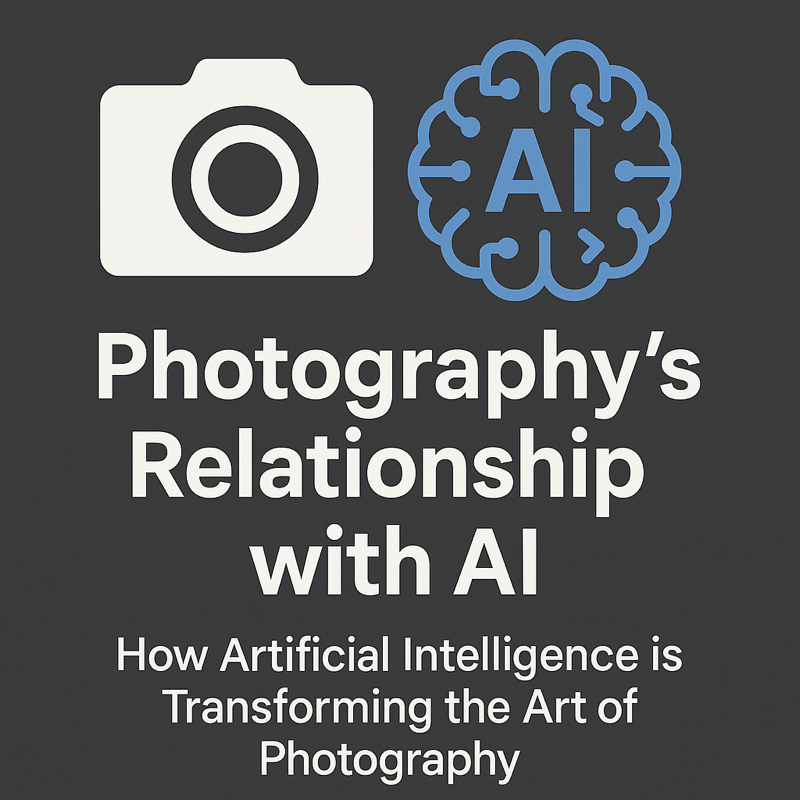Photography’s Relationship with A

How Artificial Intelligence is Transforming the Art of Photography
Photography has undergone numerous technological transformations, from film to digital and now artificial intelligence (AI). The integration of AI in photography has revolutionized image capturing, editing, and enhancement, bringing forth unprecedented possibilities. As machine learning and deep learning algorithms become more sophisticated, AI in photography is not only automating tasks but also challenging the very essence of artistic creation. This blog post explores how AI is changing photography, the tools driving these changes, and the ethical implications of AI-generated photography.
The Evolution of AI in Photography
Artificial intelligence and photography have developed a dynamic relationship, with AI enhancing every aspect of the photographic process. Traditional photography required manual adjustments and extensive post-processing, but AI-powered camera technology now enables automation and real-time enhancements.
Machine learning in photography allows devices to recognize scenes, adjust settings, and optimize image quality instantly. AI algorithms analyze lighting, subject movement, and environmental conditions to make real-time adjustments, ensuring well-balanced images. This transformation has led to features such as AI-driven autofocus, automatic exposure correction, smart HDR (High Dynamic Range) adjustments, and intelligent white balance optimization.
AI image recognition has also made it possible for cameras to detect subjects with remarkable accuracy, whether human faces, animals, or objects. Advanced AI can now differentiate between multiple elements in a frame, allowing for precise focus tracking and enhanced depth-of-field effects. These technologies ensure that photographers, from professionals to hobbyists, can capture the perfect shot with minimal user intervention, reducing the reliance on manual settings and post-processing adjustments.
AI Photo Editing: A Game-Changer for Photographers
One of the most significant advancements in AI photography tools is the rise of AI-powered photo editing software. These tools streamline complex editing tasks that once required extensive skill and effort.
AI-Driven Editing Tools
-
Adobe Sensei – Integrated into Adobe Photoshop and Lightroom, Adobe Sensei leverages AI for tasks like content-aware fill, automatic masking, and AI-based retouching.
-
Luminar Neo – This AI photo enhancement tool offers sky replacement, portrait retouching, and automatic color grading.
-
Topaz Labs AI – Uses deep learning for noise reduction, sharpening, and image upscaling without losing quality.
-
Google Photos AI Enhancements – Features AI-powered filters and automatic adjustments for lighting and contrast.
These tools enable photographers to save time while achieving professional-level results. AI photo retouching can remove blemishes, improve lighting, and even recreate missing details, making photography more accessible to amateurs and professionals alike.
AI-Generated Photography: Art or Automation?
AI-generated images have sparked debates within the creative community. With advancements in generative adversarial networks (GANs), AI can now create hyper-realistic images that are indistinguishable from real photos. From fashion and advertising to conceptual art and social media, AI-generated images are becoming increasingly mainstream, blurring the lines between authentic photography and digital creation.
How AI-Generated Photography Works
AI algorithms analyze vast datasets of images, learning patterns, textures, and compositions to generate new visuals. Tools like DALL·E, MidJourney, and Stable Diffusion use deep learning techniques to create highly realistic images based on text descriptions. These AI models can not only generate new photos but also enhance existing ones by adding missing details, colorizing black-and-white images, and even recreating historical scenes with stunning accuracy.
AI-generated photography is also making waves in creative industries. Fashion brands now use AI-generated models to showcase clothing without hiring real-life models, and video game developers create immersive worlds with AI-assisted image generation. This raises intriguing questions about the future of visual storytelling and the role of human creativity in photography.
Challenges and Ethical Concerns
-
Authenticity: AI-generated photography challenges the concept of reality in images. The ability to create highly convincing synthetic images raises concerns about misinformation, deepfakes, and the manipulation of news and historical records.
-
Intellectual Property: Who owns AI-generated art? The legal framework surrounding AI-created content remains unclear, with ongoing debates about whether ownership belongs to the AI developers, users, or the original artists whose work was used for training.
-
Impact on Jobs: AI automation in photography and editing threatens traditional roles in creative industries. However, it also opens new opportunities for those who adapt and integrate AI tools into their workflow.
-
Bias in AI Models: AI-generated images can reflect biases present in the datasets they were trained on, leading to concerns about fairness, representation, and ethical AI use in media and advertising.
-
Artistic Value: The rise of AI-generated photography prompts philosophical discussions about art’s essence. If AI can create stunning visual pieces with minimal human input, does it diminish the artistic process, or does it simply serve as a new creative tool?
Despite these concerns, AI photography tools continue to push artistic boundaries, offering unprecedented opportunities for experimentation. As AI continues to evolve, it is up to photographers, artists, and society to navigate these changes responsibly while embracing the creative possibilities AI offers.
Loss of Artistic Control
AI-driven enhancements and automation can sometimes override the creative decisions of a photographer. While AI tools aim to optimize images, they often apply standardized adjustments that may not align with the photographer’s artistic intent. Auto-corrections, such as exposure balancing, white balance adjustments, and automated retouching, can strip an image of its unique atmosphere and mood.
Furthermore, AI-powered filters and enhancement tools can create a homogenized aesthetic, making images appear overly polished or unnatural. This can be particularly problematic for photographers who specialize in fine art, documentary, or conceptual photography, where emotional depth and raw authenticity play a crucial role in storytelling.
Another concern is the potential loss of hands-on creative development. As AI increasingly handles tasks like composition, color grading, and retouching, photographers may have fewer opportunities to refine their technical and artistic skills, leading to a dependence on AI-driven presets rather than personal craftsmanship.
While AI serves as a powerful assistant, maintaining control over artistic choices requires photographers to use these tools selectively, ensuring that automation enhances rather than dominates their creative process. AI-driven enhancements and automation can sometimes override the creative decisions of a photographer. Auto-corrections and AI-generated edits may alter the intended mood, composition, or lighting of an image, reducing the photographer's ability to fully express their artistic vision.
AI-Powered Camera Technology
Modern cameras are increasingly integrating AI to enhance user experience and improve photography results. Smartphones and professional cameras alike utilize AI-driven autofocus, real-time composition analysis, and intelligent scene detection to optimize shots.
Key AI Features in Modern Cameras
-
AI Auto Focus (AF): Cameras like the Sony Alpha series use AI-driven AF to track subjects with precision, even in motion.
-
Night Mode Enhancements: AI-powered computational photography, as seen in iPhones and Google Pixels, enables detailed low-light shots without requiring a professional setup.
-
Real-Time Image Processing: AI-powered chips in smartphones analyze images instantly, applying enhancements for better clarity and color balance.
These advancements allow users to capture stunning images effortlessly, making professional-quality photography more accessible.
The Future of Photography with AI
As AI continues to advance, its role in photography will only expand. Future developments may include:
-
AI-Driven Composition Assistance: Smart cameras that analyze a scene in real time and provide framing and angle suggestions based on composition principles such as the rule of thirds, leading lines, and symmetry.
-
Real-Time AI Editing: Cameras capable of applying AI photo enhancement in real time, including automatic exposure correction, noise reduction, and intelligent color grading, minimizing the need for extensive post-processing.
-
Enhanced AI-Generated Content: AI tools that create entirely new photographic elements, enabling photographers to generate backgrounds, replace objects, and enhance realism in ways that were previously unimaginable.
-
Ethical AI Usage: Stricter regulations and guidelines to address concerns around deepfakes, AI-generated photography, and the responsible use of AI-enhanced imagery in journalism and social media.
-
Personalized AI Photography Assistants: AI-driven virtual assistants that guide photographers through different shooting conditions, suggest optimal camera settings, and even offer real-time feedback on photo composition and lighting.
AI’s impact on photography is undeniable. While some fear it may replace traditional photographers, others see it as a tool that enhances creativity and efficiency. The challenge moving forward is to find a balance between automation and artistic expression, ensuring that AI serves as a creative partner rather than a replacement for human ingenuity.
AI in Photo Restoration
One of the most remarkable applications of AI in photography is its ability to restore old, damaged, or low-quality images. AI-driven restoration tools analyze and reconstruct photographs, bringing them back to life with incredible accuracy.
How AI Restores Photos
AI-powered restoration tools use deep learning algorithms trained on vast datasets of historical and contemporary images. These algorithms can:
-
Repair scratches, tears, and stains – AI can detect imperfections and seamlessly fill in missing areas, restoring damaged photos to their original form.
-
Colorize black-and-white images – AI models can predict realistic colors based on historical references and apply them to monochrome photographs.
-
Enhance low-resolution images – AI-powered upscaling tools can add details and sharpen blurry images, making them appear clearer and more refined.
-
Remove noise and grain – AI can intelligently smooth out excessive grain or noise from old film photographs without losing crucial details.
AI-driven photo restoration is particularly valuable for preserving historical archives, reviving personal memories, and maintaining cultural heritage. By reconstructing images with remarkable precision, AI ensures that past moments can be appreciated by future generations.
The relationship between photography and AI is transforming the art of capturing and editing images. AI photo editing tools, AI-generated photography, and AI-powered camera technology are pushing the boundaries of what is possible, making photography more efficient and accessible. However, ethical considerations around AI image recognition, authenticity, and job displacement remain critical topics of discussion.
As AI continues to evolve, photographers must embrace these advancements while preserving the essence of creativity. Whether you’re a professional photographer or an amateur, understanding and utilizing AI photography tools will be essential in staying ahead in the ever-changing world of photography.








